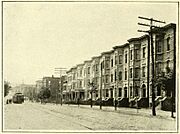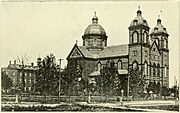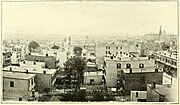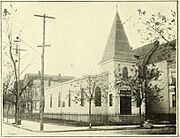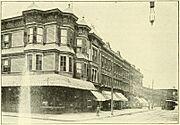West Hoboken, New Jersey facts for kids
Quick facts for kids
West Hoboken
|
|
|---|---|
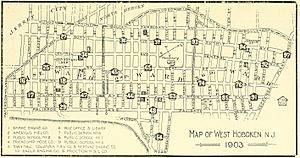 |
|
| Country | |
| State | |
| County | |
| Founded | February 28, 1861 |
| Merged | June 1, 1925 |
| Historical population | |||
|---|---|---|---|
| Census | Pop. | %± | |
| 1870 | 4,232 | — | |
| 1880 | 5,441 | 28.6% | |
| 1890 | 11,665 | 114.4% | |
| 1900 | 23,094 | 98.0% | |
| 1910 | 35,403 | 53.3% | |
| 1920 | 40,074 | 13.2% | |
| Population sources: 1870-1920 | |||
West Hoboken was a town in Hudson County, New Jersey. It existed from 1861 until 1925. On June 1, 1925, West Hoboken joined with another town called Union Hill. Together, they formed a new city known as Union City.
West Hoboken is famous for one special thing: it was the first place where Mallomars cookies were sold!
Contents
History of West Hoboken
How West Hoboken Started
The land where West Hoboken was built first belonged to the Lenape Native Americans. They spoke the Munsee language. These people lived in the large forests seen by Henry Hudson in 1609 and 1610. Hudson was exploring for the Dutch.
The Dutch later claimed this area, including what is now New York City. They called it New Netherland. In 1658, a Dutch leader named Peter Stuyvesant bought the land that became Hudson County. He bought it from the Hackensack tribe of the Lenape.
The payment for the land included:
- 80 fathoms of wampum (beads used as money)
- 20 fathoms of cloth
- 12 brass kettles
- 6 guns
- One double brass kettle
- 2 blankets
- Half a barrel of strong beer
Early Settlements and Changes
The Dutch settlers and Native Americans sometimes fought over land. To protect the area, Peter Stuyvesant ordered a fortified village called Bergen to be built in 1660. This was the first permanent European settlement in New Jersey. It is now part of Jersey City.
In 1664, the British took control of New Netherland from the Dutch. The area of Bergen Township then covered what is now Hudson County. North of this was a wild area called Bergen Woods. Later, settlers moved there. Some streets in Union City today are named after these early settlers. For example, Kerrigan Avenue is named after J. Kerrigan. He owned Kerrigan Farm and gave land for Saint Michael's Monastery.
The area that became West Hoboken did not have many people until the early 1800s. In 1668, the British gave Bergen a new town charter. In 1682, they created Bergen County. This county was named after the Dutch settlement. It included all of present-day Hudson, Bergen, and Passaic counties.
Forming New Towns
By the early 1800s, the southeast part of Bergen County had grown. It was decided to make it a separate county. The New Jersey government created Hudson County in 1840. In 1843, Hudson County was split into two parts:
- Old Bergen Township (which became Jersey City)
- North Bergen Township
North Bergen Township was later divided into several towns:
- Hoboken (1849)
- Weehawken and Guttenberg (1859)
- Union City Township (1861), also known as Union Hill
West Hoboken officially became a township on February 28, 1861. It was formed from parts of North Bergen Township. A township is a type of local government area.
West Hoboken was made a township again in 1871 and 1874. Some parts of it were given to Weehawken in 1879. On June 28, 1884, West Hoboken became a town. It was reincorporated as a town again in 1888.
Finally, on June 1, 1925, West Hoboken and Union Hill joined together. They formed the new city of Union City.
- Photographs of West Hoboken
-
St. Michael's Monastery, located at Monastery Place and West Street
Business and Shopping Areas
As mentioned, Mallomars cookies were first sold in a grocery store in West Hoboken.
The town had two main shopping areas:
- Transfer Station at Paterson Plank Road and Summit Avenue. This was in the southern part of town.
- Bergen Turnpike, which was near the border with Union Hill.
Notable People from West Hoboken
Many interesting people were born in or lived in West Hoboken. Here are some of them: (B) means the person was born there.
- Charles Avedisian (1917–1983): A football player who played for the New York Giants in the NFL. (B)
- Pietro Botto (1864–1945): He owned the Pietro and Maria Botto House in Haledon, New Jersey. This house was important during the 1913 Paterson Silk Strike. He moved to West Hoboken from Italy in 1892.
- James E. Buttersworth (1817–1894): A British artist famous for painting ships and scenes at sea.
- Rene Paul Chambellan (1893–1955): A talented sculptor known for his architectural sculpture. He was a leader in the Art Deco style. (B)
- Pietro di Donato (1911–1992): A writer known for his novel, Christ in Concrete. (B)
- Antonio Jacobsen (1850–1921): Another maritime artist, often called the "Audubon of Steam Vessels" because he painted so many ships.
- Joe Jeanette (1879–1958): Considered one of the best African American heavyweight boxers in the early 1900s. (B)
- Ada Lunardoni (1911–2003): An artistic gymnast who competed in the 1936 Summer Olympics. Her team placed fifth. (B)
- Otto Messmer (1892–1983): The amazing creator of Felix the Cat! (B)
- Ioan Missir (1890–1945): A Romanian lawyer, politician, and writer.
- William Musto (1917–2006): He served as the Mayor of Union City for many years.
- Arthur Pinajian (1914–1999): An Armenian American artist and comic book creator. He created characters like Madame Fatal and Invisible Hood.
- William Ranney (1813–1857): A painter known for his art showing Western life, sports, history, and portraits.
- Alvin Sella (c. 1920–2013): A painter and teacher. (B)
- Walter Walsh (1907–2014): An FBI agent, a shooting instructor for the U.S. Marine Corps, and an Olympic shooter.
- Gene Wettstone (1913–2013): A gymnastics coach who led Pennsylvania State University to nine national championships. He also coached the U.S. men's teams in the 1948 and 1956 Summer Olympics.


